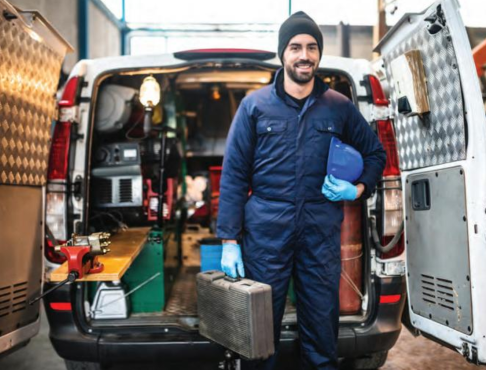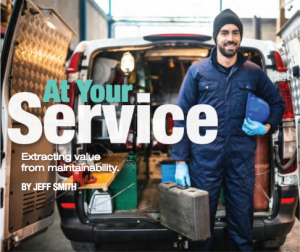
At your service – Extracting value from maintainability
December 11, 2017 | By Jeff Smith


Photo: Getty Images.
As a tradesman, “maintainability” wasn’t a word I thought about when something was inaccessible or removals required a contortionist with a handful of various extensions. I used different words. They were eloquent strings of disjointed words that clearly demonstrated the versatility of the English language. Regardless of the sentence structure, it always ended in “engineer!” How is it that so many items are manufactured with no thought to maintainability? MTTR (Mean Time to Repair) is a key factor in keeping assets delivering on their value proposition. Things like removing a transmission in a loader: step one-remove cab… #$@$Engineer! (Oops, inner voice.)
When developing assets, there are often constraints the end user may not be aware of, such as financial decisions driving capital availability. I experienced an example of this at a pulp mill. The chipping line had thawing ponds and a chain ladder to a chain conveyor run, which feed logs through the debarking ring and chipper. The mill was about 15 years old when the chipper motor failed. It was about 600 hp, so it was quite big and we didn’t think to have a spare. Walking to the motor on an elevated platform in the middle of the wood room with the lockout completed, the situation hit us. There is no way to lift the motor as small cranes could not get close enough inside the mill with the spider’s web of piping and equipment.
I looked over the situation and asked, “Why wouldn’t there be an overhead crane over the whole chipping line?” As it turns out, the original plan was to have one. The building I beams were positioned correctly and strong enough to support one. The answer was simple: It would have been an extra $200,000 and the capital group decided to save money. The job could have been completed in about eight hours if there had been an overhead crane, so it would have resulted in about $333,000 of production loss. So let’s say the total costs had they installed the crane would have been around $50,000.
But with no crane, we needed a contingency plan. We called for a mobile crane (a very large track crane). It was not that the motor was that heavy, but the lift required it to be conducted from the log yard, hence reaching over the building. We removed the roof panels, reached over the building and removed the motor. We then replaced the motor and the mill was up and running. So let’s take a look at the costs associated with intervention with no overhead crane.
Production loss: seven days at $1million per day plus $100,000 for the crane to be assembled on site). The cost of the non maintainable motor was $7,100,000 in lieu of a $200,000 trolley crane.
Being quite naïve at the time, and after everything was done, I asked the manager if we were going to create a budget in order to put in a trolley crane. To which the manager replied, “Of course we are not getting one, cranes are $200,000!”
So how does one derive value from evaluating maintainability? When the system fails to provide its function and we have to intervene, it is basically as maintainable as its initial design allowed it to be. So at that point, we are at the mercy of the designer. So let’s first explore how maintainability could be established by the design team. When an asset is designed, regardless if it’s a plant or a haul truck, the structure is developed. The big blocks are drawn in place and then the supporting systems are installed. We (the purchaser) always want space, cost, durability and functionality provided. We want all the bells and whistles at the minimal cost. The manufacturer has a competing agenda; he wants to make money off his product. The actual people who manufacture assets do so in stages: structures, piping, hydraulics, pneumatics, electrical and monitoring systems are layered on. When supporting systems are designed, there seems to be a disconnect between designers and whomever’s system is last crammed into the remaining area. Only recently has RAM (Reliability, Availability and Maintainability) modelling become a normal part of asset design.
To truly have maintainable assets every component and every system should be reviewed for optimal maintainability. If it’s designed to maintain, the end users will like it. In the design phase, get a trades perspective on placement and fastening; and have product reviews that get all sub-system designers to work together. To help this concept make sense, consider building a house. If the plumber has no regard for the electrical and the HVAC people don’t care where the plumbing goes, you will get three trades in conflict over routing. All must work together.
If you are a tradesperson in the asset construction world, constantly review what’s being constructed and speak up! Just because the drawing has stairs covering the asset doesn’t make it right.
Maintainability design points:
- Consider access to all fasteners and connections.
- Review component lifting requirements over the assets lifecycle.
- Consider human ergonomics in machine placement and spacing.
- Consider work zones and design platforms to minimize scaffolding requirements.
- Review interrelationships of all supporting systems, (piping, cable trays, process flows, lighting, guarding, ingress/egress etc.).
- Remember: It can look great on paper, but review constantly in the construction phase.
With running facilities, you no longer have the luxury of designing it correctly, but you do have options. When your asset fails and you need to execute the work, you will have to resort to whatever maintainability you have. But let us consider something; work can be post planned! If a job is hard to do and you are not working to a detailed job scope, it should be conveyed to planning that this job would be easier if, for example, a custom lifting device was manufactured, stairs were relocated, access panels cut, or guard fasteners reworked. The majority of tasks you do in an industrial facility will be repeated over years or decades. If a one-hour modification saves days of MTTR than it should be follow-up work.
For proactive companies maintainability should never be a surprise. Proactive planners have the job planned long before it is actually required. When I develop structured work programs, I list all secondary actions and initiate planning. The term secondary action describes what would be required if I detected an impending failure. For example, if I know I need to conduct vibration analysis on a motor, I have already made a determination that it will fail at some point. Therefore, I need a work package developed to cover all aspects of the replacement.
Here is a challenge: check out the things you are conducting CBM on and look for the pre-planned work packages to address the failure. If you don’t find any, then you are not really ready for secondary action. You may detect the bearing failure but it’s too late to see if the part is stocked or if any specialty tools are required, etc. Planning should be proactive. Think back to the electric motor failure. Had we pre-planned that, we may not have had a trolley crane but we could have installed an I-beam or Jib just for that motor. Or, at the very least, we would know the risk we were exposed to.
Maintainability Improvement Points:
- Survey your assets to identify potential maintainability improvement projects.
- Locations of stairs or hard-to-access equipment
- Design of guards and covers for removability
- Study pathways for access of large components
- Consider lifting requirements, pre-engineer lifting points.
- Consider covers to avoid process spillage (extended cleanup times)
- Evaluate potential asset relocation upon failure
- Review tasks to see if there are maintainability improvements.
- Review lube routes considering greasing access or piping requirements
- Review Vibrations data collection for bearing access
- Consider infra-red windows
- Review all routine tasks from a maintainability perspective.
Maintainability is the ability of an item, which is under specific conditions of use, to be retained in, or restored to, a state in which it can perform its required functions when maintenance is performed under stated conditions, using prescribed procedures and resources.
Maintainability is one of the easiest areas to reduce downtime, so find that one asset that every tradesperson hates working on and make it more maintainable. Also, do not get caught up in job magnitude; improvements in maintainability on smaller frequent tasks create value fast!
Jeff Smith is a reliability subject matter expert and the owner of 4TG Industrial. His work spans a cross-section of industries, including oil sands, mining, pulp and paper, packaging, petrochemical, marine, brewing, transportation, synfuels and others. Reach him at smith@4tg-ind.ca or visit www.4tg-industrial.com.
A version of this article ran in the December 2017 issue of Machinery and Equipment MRO.
